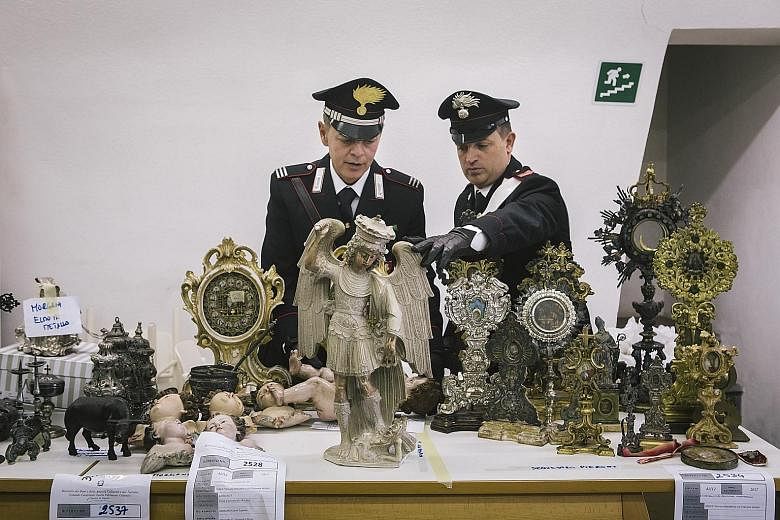ROME • The prayers for its safe recovery were answered, leading to the recent joyous return to Monteroduni of a 16th-century statue of the archangel Michael.
It had been stolen by thieves some 20 months earlier.
The investigation that led to its recovery and that of objects stolen from dozens of churches throughout Italy and abroad turned out to be "one of the most important operations in recent years", said Mr Paolo Albano, chief prosecutor of the nearby town of Isernia, who coordinated the case.
But the inquiry also underscored the fragility of Italy's ecclesiastical patrimony, scattered among the country's more than 60,000 churches, a treasure trove that includes masterpieces by Titian, Michelangelo and Caravaggio as well as statues and precious artefacts such as chalices and manuscripts.
Of the 449 thefts registered last year by the art-theft investigative unit, just under half occurred in churches.
The isolation of many churches makes them hard to protect from such thefts.
Closing churches is one option, but for the Roman Catholic hierarchy, "a closed church is a loss", said Reverend Valerio Pennasso, director of the Italian Bishop Conference's national office for ecclesiastical heritage.
So dioceses do what they can to keep places of worship open - for the faithful and tourists alike - even outside liturgical hours.
The church is not sitting by idly in the face of thefts, though.
Since 1996, clerics have been called on to photograph and document their churches' assets, which have now been catalogued in an Italy-wide database.
Any objects that go missing are also added to the art-theft unit's own database of stolen art, which at more than 1.2 million images is the largest such catalogue in the world.
Guidelines have been drafted to better protect churches from theft and vandalism - with suggestions such as having volunteers monitor churches, substituting valuables with copies and fixing artefacts in place.
And about 20 years ago, the bishop's conference began setting aside about €19,000 (S$30,000) a year to help churches install alarms and implement safety measures such as barriers and closed-circuit television cameras.
At the same time, many churches have transferred their most precious artefacts to local diocesan museums, where security systems are more advanced.
That was not a viable option for the archangel statue in Monteroduni, an object of devotion that had been prominently placed in the main nave so that people could pray before it. The statue, along with a shield and sword, was returned to Monteroduni on Sept 29, the patron saint's day.
It was placed in a side chapel during mass after the procession, but at nightfall, Reverend Paolo Paulin, the parish priest, retired it to "a safe place".
"Clearly, we can't leave things of value inside the church," he said, "because there will always be scoundrels around."
NYTIMES

